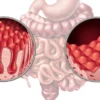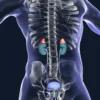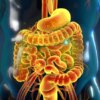
Functional dyspepsia is a common digestive complaint that describes a combination of gastric symptoms. These include stomach pain and discomfort, heartburn and bloating, which commonly appear following a meal.
In a similar way to an IBS diagnosis, functional dyspepsia is diagnosed once other causes of the symptoms have been excluded. For many, this can be a chronic or long-term condition.
What is Functional Dyspepsia?
Functional dyspepsia is also known as indigestion, a general term for symptoms related to the digestive process. This diagnosis is made following examinations to exclude other causes of the symptoms.
This would include excluding infections such as H Pylori and a hiatus hernia. This means that a diagnosis of functional dyspepsia is made following the exclusion of specific causes.
This does not mean that the condition is not real, just that tests are not always able to find the cause.
Symptoms of Functional Dyspepsia
A range of symptoms is commonly present in functional dyspepsia. Generally, most of the symptoms appear in most cases, however, their severity or intensity can vary between individuals.
Early Fullness
- Following a meal, there can be the sensation of being overly full or feeling full very quickly. This may be due to excess gas being produced or increased sensitivity in the nerves in the upper gut.
Upper Abdominal Pain or Discomfort
- Similarly to early fullness, pain or discomfort in the upper gut can often depend on increased gas combined with nerves that are overly sensitive. Commonly referred to as visceral hypersensitivity, this increases the pain response, contributing to these symptoms.
Bloating
- While bloating can be caused by swallowing air or eating too quickly, in functional dyspepsia, it’s commonly related to digestive insufficiencies, alterations in the gut microbiome and nerve sensitivity.
Nausea
- Excess pressure in the bowel, as well as gut lining irritation, is a common cause of nausea. This can also be related to maldigestion, leading to certain foods not being fully absorbed and then leading to symptoms.
Burping and Acid Regurgitation
- The upward movement of gas and stomach contents is common. This can lead to belching, heartburn and acid or even food making its way back up into the oesophagus, throat or mouth.
Causes and Risk Factors
While the symptoms of dyspepsia may be easy and quick to identify, a successful treatment approach requires identifying and addressing the underlying factors.
These factors may be identified via further examination, either via tests or a clinical assessment questionnaire.
Delayed Stomach Emptying (Gastroparesis)
- Delayed emptying of the stomach can lead to heaviness and the feeling of being overly full. This can also lead to more pressure building in the stomach, which can contribute to acid moving up into the throat and oesophagus, leading to symptoms of heartburn.
Hypersensitivity to Stomach Stretching
- Irritation and low-grade inflammation in the stomach and small intestine can lead to increased nerve sensitivity. This hypersensitivity can lead to increased discomfort, even with a small amount of pressure building in the bowel. Often, there is increased pressure, which can lead to increased pain.
SIBO (Small Intestinal Bacterial Overgrowth)
- An overgrowth of bacteria in the small intestine can lead to more gas being produced, which then leads to acid and stomach contents irritating the oesophagus.
Stress and Psychological Factors
- Stress can lead to a wide range of disturbances in the gut. This can include changes in the gut microbiome, increased nerve sensitivity and activation of the immune response. Alterations to the gut-brain connection can also be a key aspect of disruption that can contribute to dyspepsia.
Helicobacter Pylori (H. pylori) Infection
- H pylori is a stomach infection that can lead to symptoms of dyspepsia and heartburn. This infection impacts the cells along the gut that protect it from stomach acid, therefore, this infection can contribute to sores and inflammation in the stomach as well as the small intestine.
Diet and Lifestyle Factors
- Diet factors such as highly refined and ultra-processed foods, high fat content and excessive alcohol are all considered to be risks for impacting and injuring the bowel. Smoking and poor sleep are also considered to be diet and lifestyle factors that increase the risk of functional dyspepsia developing and progressing.
Diagnosis of Functional Dyspepsia
The diagnosis of functional dyspepsia is normally based on a set of symptoms being present once other causes have been excluded. In this way, this diagnostic process is similar to that used in IBS.
Medical History and Symptom Assessment
Along with reviewing a patient’s medical history, a specific set of symptoms is outlined in the ROME IV criteria.
These require symptoms to have been present for 3 months with no structural cause of the symptoms to be found, along with 1 or more of the following:
- Postprandial fullness (overly full after eating)
- Early satiety (feeling full very quickly)
- Epigastric pain
- Epigastric burning
Tests to Rule Out Other Conditions
As this is a condition of exclusion, certain causes of the symptoms need to be ruled out before a diagnosis is given. This often involves further tests to be carried out which include:
- Upper endoscopy (esophagogastroduodenoscopy, EGD): To exclude ulcers, cancer, gastritis, or reflux esophagitis.
- H. pylori testing: Breath test, stool antigen, or biopsy during endoscopy.
- Blood tests: To rule out anaemia, infection, or other systemic conditions.
- Imaging (occasionally): Such as ultrasound or CT if gallbladder or pancreatic disease is suspected.
Treatment and Management of Functional Dyspepsia
While management of functional dyspepsia is often a way to keep symptoms under control, the aim of treatment is to address the underlying issue. Here are several ways to address functional dyspepsia.
Dietary Changes
A range of dietary changes can be considered to help address dyspepsia.
The first consideration can be meal timing, spacing and size. Eating meals that are too big can lead to delayed gastric emptying, so smaller meals and more frequent ones may help to manage symptoms.
While specific triggers can vary from person to person, common triggers can include:
- High-fat meals (due to fat delaying gastric emptying)
- High FODMAP foods (due to more gas being produced in certain patients)
- Spicy foods
- Acidic foods (citrus, tomatoes)
- Carbonated beverages
- Caffeine
- Alcohol
- Chocolate
It can also be helpful to chew food thoroughly and to leave at least 2-3 hours before the last meal before going to bed.
Medications
The 2 main types of medications are often considered for functional dyspepsia.
- Acid Suppressants
- Prokinetics
The main types of acid suppressants are PPIs (Omeprazole, lansoprazole and esomeprazole), which may be best considered for epigastric pain. H2-receptor antagonists (H2RAs) such as Famotidine are often considered for milder cases or when PPIs are not tolerated.
Prokinetics (domperidone, metoclopramide) can be used to help speed up gastric emptying. These may be best used in cases where the is more discomfort following a meal.
Stress Management and Psychological Therapies
Additional therapies can help with functional dyspepsia in a number of ways. This can be due to increased stress leading to alterations in digestive function, contributing to symptoms.
It can also be that increased stress can lead to increased sensitivity to pain. This may be in the form of heightened sensitivity in the nerves in the gut, but also more activation in the regions of the brain that register that pain.
The two most commonly used therapies are:
- CBT (Cognitive Behavioural Therapy)
- Gut-directed hypnotherapy
These can help to calm the stress response, which then allows the gut to calm. Due to the higher rates of anxiety and depression in those with functional dyspepsia, this is an important area. Particularly, in patients who have not responded to other treatments.
Other forms of stress management support include:
- Mindfulness-Based Stress Reduction
- Progressive Muscle Relaxation
- Breathing Exercises and Biofeedback
When to See a Doctor
While any symptom can lead to booking an appointment with a doctor, certain symptoms can be described as red flag symptoms. These may require further assessments or tests and include:
- Unintended weight loss
- Vomiting
- Difficulty swallowing (dysphagia)
- Evidence of gastrointestinal bleeding (e.g., black stools, anaemia)
- Family history of gastrointestinal cancer
- Age >60 with new-onset symptoms
Conclusion
Functional dyspepsia can be a common diagnosis and does not lead to increased risk of further digestive issues, however, it can be a chronic situation for many patients.
While there are many forms of symptom management, working to address the underlying issues can be a focus of a successful treatment plan.
Contact us today to have your symptoms assessed by our gut health specialist.
References
1. Mayo Clinic – Functional dyspepsia – Symptoms and causes
2. Cleveland Clinic – Functional Dyspepsia: What It Is, Symptoms & Treatment
3. Guts UK – Functional Dyspepsia
4. Healthline – Functional Dyspepsia: Definition, Causes, Symptoms, Diagnosis,
5. American Family Physician – Functional Dyspepsia: Evaluation and Management
6. NCBI Bookshelf – Functional Dyspepsia – StatPearls
7. Northwestern Medicine – Functional Dyspepsia Overview
8. Patient.info – Functional Dyspepsia (Non-ulcer Dyspepsia)
9. Verywell Health – Dyspepsia
10. Harvard Health Publishing – Functional dyspepsia: Causes, treatments, and new directions
Last Updated
Uploaded by Martin Cohen on 28/05/2025






